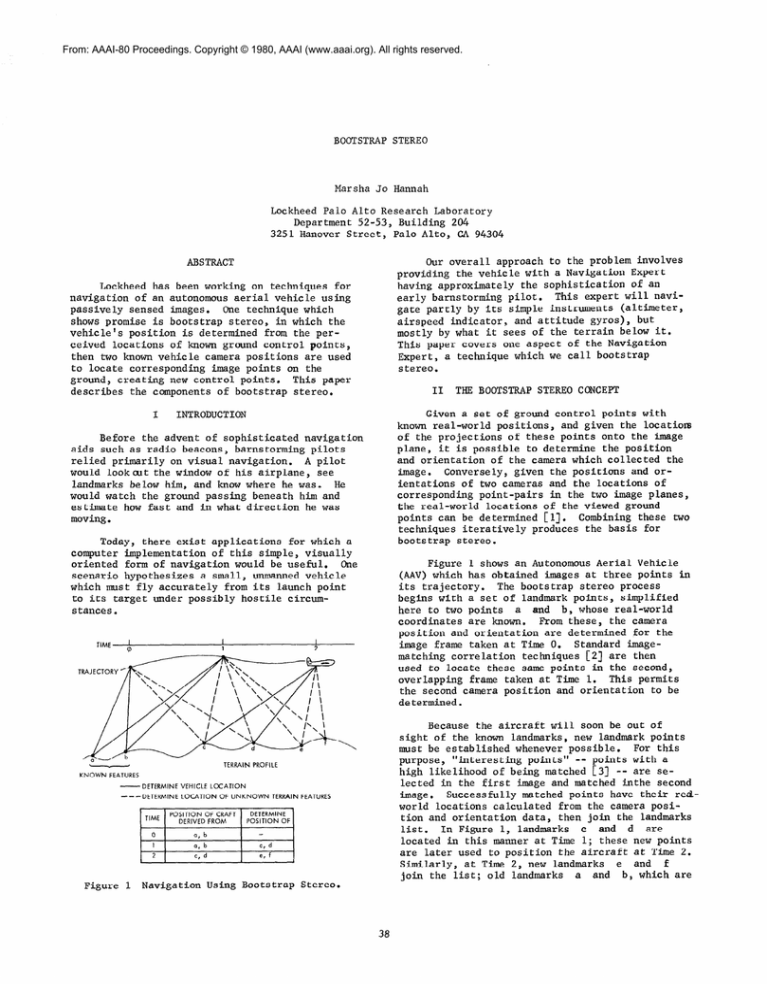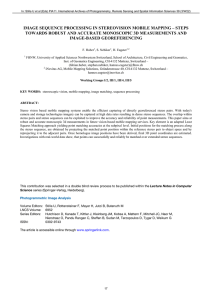
From: AAAI-80 Proceedings. Copyright © 1980, AAAI (www.aaai.org). All rights reserved.
BOOTSTRAP STEREO
Marsha Jo Hannah
Lockheed Palo Alto Research Laboratory
Department 52-53, Building 204
3251 Hanover Street, Palo Alto, CA 94304
Cur overall approach to the problem involves
providing the vehicle with a Navigation Expert
having approximately the sophistication of an
early barnstorming pilot. This expert will navigate partly by its simple instruments (altimeter,
airspeed indicator, and attitude gyros), but
mostly by what it sees of the terrain below it.
This paper covers one aspect of the Navigation
Expert, a technique which we call bootstrap
stereo.
ABSTRACT
Lockheed has been working on techniques for
navigation of an autonomous aerial vehicle using
passively sensed images. One technique which
shows promise is bootstrap stereo, in which the
vehicle's position is determined from the perceived locations of known ground control points,
then two known vehicle camera positions are used
to locate corresponding image points on the
ground, creating new control points. This paper
describes the components of bootstrap stereo.
II
INTRODUCTION
I
Given a set of ground control points with
known real-world positions, and given the 1ocatioIs
of the projections of these points onto the image
plane, it is possible to determine the position
and orientation of the camera which collected the
image. Conversely, given the positions and orientations of two cameras and the locations of
corresponding point-pairs in the two image planes,
the real-world locations of the viewed ground
points can be determined [l]. Combining these two
techniques iteratively produces the basis for
bootstrap stereo.
Before the advent of sophisticated navigation
aids such as radio beacons, barnstorming pilots
relied primarily on visual navigation. A pilot
would lookart the window of his airplane, see
landmarks below him, and know where he was. He
would watch the ground passing beneath him and
estimate how fast and in what direction he was
moving.
Today, there exist applications for which a
computer implementation of this simple, visually
oriented form of navigation would be useful. One
scenario hypothesizes a small, unmanned vehicle
which must fly accurately from its launch point
to its target under possibly hostile circumstances.
I
1
L
KNOWN
-
Figure 1 shows an Autonomous Aerial Vehicle
(AAV) which has obtained images at three points in
its trajectory. The bootstrap stereo process
begins with a set of landmark points, simplified
here to two points a and b, whose real-world
coordinates are known. From these, the camera
position and orientation are determined for the
image frame taken at Time 0. Standard imagematching correlation techniques [23 are then
used to locate these same points in the second,
overlapping frame taken at Time 1. This permits
the second camera position and orientation to be
determined.
I
2
TERRAIN
Because the aircraft will soon be out of
sight of the known landmarks, new landmark points
must be established whenever possible. For this
purpose, "interesting points" -- points with a
high likelihood of being matched [3] -- are selected in the first image and matched inthe second
image. Successfully matched points have their redworld locations calculated from the camera position and orientation data, then join the landmarks
list. In Figure 1, landmarks c and d are
located in this manner at Time 1; these new points
are later used to position the aircraft at Time 2.
Similarly, at Time 2, new landmarks e and f
join the list; old landmarks a and b, which are
PROFILE
FEATURES
-DETERMINE
VEHICLE
---DETERMINE
LOCATION
TIME
I
OF UNKNOWN
TERRAIN
FEATURES
DETERMINE
POSITION
OF
:
0
t
LOCATION
POSITION
OF CRAFT
DERIVED FROM
I
0, b
1
1
0, b
2
I
c. d
I
c, d
I
e.f
THE BOOTSTRAP STEREO CONCEPT
Figure 1 Navigation Using Bootstrap Stereo.
38
image being matched via a spiral search. Thereafter, each matched point spawns four points
around itself, offset by half a window radius
along the diagonals of the window. These are
mapped down to the next level of images, carrying
their parent's displacement (suitably magnified)
as their suggested match approximation. These
matches are refined by a spiraling search before
spawning new points. This process continues
until the largest images are reached, effectively
setting up a grid of matched points.
no longer in the field of view, are dropped
the landmarks list.
Once initialized from a set of known landmarks, bootstrap stereo has four components -camera calibration, new landmark selection, point
matching, and control point positioning. Because
camera calibration and control point positioning
have been well covered in the photogrammetric and
imaging literatures (e.g., [1], [4], [S], [63),
we will discuss only landmark selection and point
matching in the following sections.
III
In our implementation of bootstrap stereo,
reduction matching is used to determine approximate registration of the images and to initialize the second-order match prediction polynomials.
Matching of old landmarks and of interesting points
to create new landmarks uses these polynomials to
predict an approximate match, which is then refined by a local search. Autocorrelation thresholding is used to test the reliability of the match,
then points are located more closely than the image
grid permits by parabolic interpolation of the Xand Y-slices of the correlation values.
NEW LANDMARK SELECTION
Because the aircraft rapidly moves beyond the
known landmarks, new landmark points must constantly be established. For this purpose, "interesting
points" -- points with a high likelihood of being
matched [3] -- are selected in the old image of
each pair, then matched with their corresponding
points in the new image and located on the terrain.
Matching is done on the basis of the normalized cross-correlation between small windows of
data (typically 11 x 11) around the two points in
question. Matching has trouble in areas that contain little information or whose only information
results from a strong linear edge, therefore such
areas make poor candidate landmarks.
V
In Figure 2, we present an example of the
control-point handling portion of bootstrap
stereo. The original data set, a sequence of
3 images from a video tape taken over the Night
Vision Laboratory terrain model, is shown in
Figure 2a.
To avoid mismatches from attempting to use
such aras, various measures on the information in
the window have been used, including the simple
statistical variance of the image intensities over
the window [2] and the minimum of the directed
variances over the window [3]. We have combined
these into another interest measure which we call
edged variance, which appears to perform better
than either of its components [7].
Figure 2b shows the interesting points in
the first image, indicated by + overlays. If
these were the control points from a landmark
processor, we would use them to locate the first
camera. These landmark points are next matched
with their corresponding points in the second
image; Figure 2c shows the successful matches
overlaid on the first and second images. From
the image plane positions of these points, the
position and orientation of the second camera
are determined.
We have defined our interesting points to be
those which are local peaks in our interest
measure, with a lower bound established to reject
undesirable areas. Figure 2 includes some
examples of the application of this interest
measure.
IV
ANEXAMPLE
Next, the areas of the second image which
were not covered by matches are blocked out and
interesting points are found in the uncovered
areas, as seen in Figure 2d. The old landmark
points and the interesting points are then
matched in the third image, as shown in Figure
2e. The old control points from the second
image are used to calibrate the third camera;
the camera calibrations are then used to locate
the matched interesting points on the ground,
forming new control points. These two steps
are then repeated for subsequent pairs of
images in longer sequences.
POINT MATCHING
The actual matching of points in an image
pair is done by maximizing normalized crosscorrelation over small windows surrounding the
points. Given an approximation to the displacement which describes the match, a simple spiraling grid search is a fairly efficient way to
refine the precise match [2J. To provide that
initial approximation, we have employed a form
of reduction matching [3].
We first create a hierarchy of N-ary reducsquare of pixels in
tion images. Each NxN
an image is averaged to form a single pixel at
the next level. This reduction process is repeated at each level, stopping when the image
becomes approximately the size of the correlation
windows being used. Matching then begins at the
smallest images, with the center point of the first
VI
CONCLUSICNS
When an autonomous aerial vehicle must
navigate without using external signals or radiating energy, a visual navigator is an enticing
possibility. We have proposed a Navigation Expert
capable of emulating the behavior of an early barnstorming pilot in using terrain imagery. One tool
39
such a Navigation Expert could use is bootstrap
stereo. This is a technique by which the vehicle's
position is determined from the perceived positions
of known landmarks, then uses two known camera
positions to locate real-world points which serve
as new landmarks.
Moravec, H. P., "Visual Mapping by a Robot
Rover", Proceedings of the 6th IJCAI, Tokyo,
Japan, 1979.
Duda, R. 0. and P. E. Hart, Pattern Classification and Scene Analysis, John Wiley and
Sons, New York, New York, 1973.
The components of bootstrap stereo are well
established in the photogrammetry and image processing literature. We have combined these, with
improvement, into a workable system. We are working on an error simulation, to determine how the
errors propagate and accumulate.
VII
Cl3
C23
Fischler, M. A. and R. C. Bolles, "Random
Sampling Consensus", Proceedings: Image
Understanding Workshoe, College Park, Maryland, April 30, 1980.
REFERENCES
Gennery, D. B., "A Stereo Vision System for an
Autonomous Vehicle", Proceedings of the 5th
IJCAI, Cambridge, Massachusetts, 1977.
Thompson, M. M., Manual of Photogrammetry,
American Society of Photogrammetry, Falls
Church, Virginia, 1944.
Hannah, M. J., "Bootstrap Stereo", Proceedings:
Image Understanding Workshop, College Park,
Maryland, April 30, 1980.
Hannah, M. J., Computer Matching of Areas in
Stereo Image=, PhD,Thesis, AIM#239, Computer
Science Department, Stanford University,
California, 1974.
Figure 2
An Example of the Control-Point Handling for Bootstrap Stereo
a>
The original sequence of 3 images.
b)
The interesting points in Image 1.
c)
The matched points between Images 1 and 2.
d)
The areas of Image 2 covered by matches, with interesting points found in the uncovered areas.
e)
The control points in Image 2 matched to Image 3.
40






